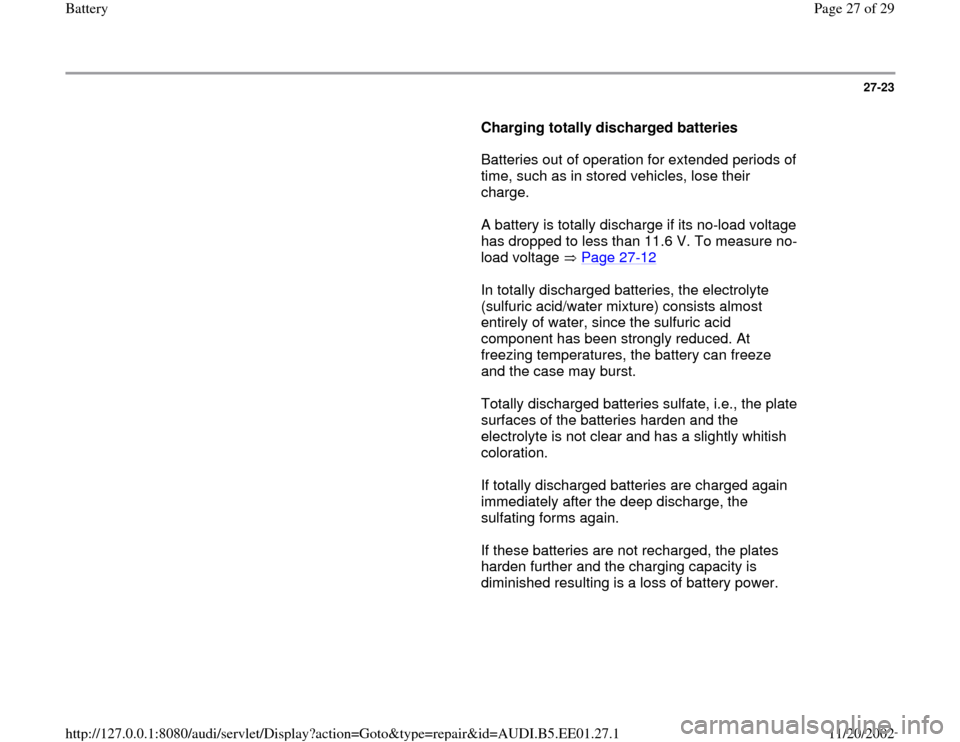Page 25 of 29
charging damages batteries.
If totally discharged batteries are fast-charged,
either they will not accept any charging current
or they will appear to be fully charged too early
due to a "surface charge" and will only appear
to be OK.
Pa
ge 25 of 29 Batter
y
11/20/2002 htt
p://127.0.0.1:8080/audi/servlet/Dis
play?action=Goto&t
yp
e=re
pair&id=AUDI.B5.EE01.27.1
Page 26 of 29
27-22
Battery charging procedure
- Switch off battery charger.
- Switch ignition off.
- First disconnect battery Ground (GND) strap;
then disconnect positive cable from battery.
- Connect positive cable of battery charger to
positive terminal of battery.
- Connect negative cable of battery charger to
negative terminal of battery.
- Adjust charging current on battery charger to
battery capacity. It should be equivalent to
approximately 10% of battery capacity or about
6 A for 60 Ah battery.
- Switch on battery charger.
Pa
ge 26 of 29 Batter
y
11/20/2002 htt
p://127.0.0.1:8080/audi/servlet/Dis
play?action=Goto&t
yp
e=re
pair&id=AUDI.B5.EE01.27.1
Page 27 of 29

27-23
Charging totally discharged batteries
Batteries out of operation for extended periods of
time, such as in stored vehicles, lose their
charge.
A battery is totally discharge if its no-load voltage
has dropped to less than 11.6 V. To measure no-
load voltage Page 27
-12
In totally discharged batteries, the electrolyte
(sulfuric acid/water mixture) consists almost
entirely of water, since the sulfuric acid
component has been strongly reduced. At
freezing temperatures, the battery can freeze
and the case may burst.
Totally discharged batteries sulfate, i.e., the plate
surfaces of the batteries harden and the
electrolyte is not clear and has a slightly whitish
coloration.
If totally discharged batteries are charged again
immediately after the deep discharge, the
sulfating forms again.
If these batteries are not recharged, the plates
harden further and the charging capacity is
diminished resulting is a loss of battery power.
Pa
ge 27 of 29 Batter
y
11/20/2002 htt
p://127.0.0.1:8080/audi/servlet/Dis
play?action=Goto&t
yp
e=re
pair&id=AUDI.B5.EE01.27.1
Page 28 of 29
27-24
Procedure for charging totally discharged,
sulfated batteries
Totally discharged, sulfated batteries must be
charged with a low charging current as follows:
- Set charging current to approximately 5% of
battery capacity, (e.g., for 60 Ah battery,
charging current should be about 3 amps).
To charge the battery Page 27
-22
. The
charging voltage must not exceed 14.4 volts.
Never fast-charge totally discharged batteries.
Note:
Once the battery is reconnected, check and
activate the vehicle's electrical equipment (radio,
clock, comfort and convenience features, etc.) as
described in this Repair Manual or the Owners
Manual.
Pa
ge 28 of 29 Batter
y
11/20/2002 htt
p://127.0.0.1:8080/audi/servlet/Dis
play?action=Goto&t
yp
e=re
pair&id=AUDI.B5.EE01.27.1
Page 29 of 29
27-25
Fast-charging/boost starting
Notes:
Batteries should be fast-charged (charging
current approximately 20% of battery capacity
and higher) only under exceptional
circumstances.
Batteries are damaged by fast-charging.
Boost starting is also possible using the
VAG1472 starter/charger.
The VAS1992 battery-starter provides boost
starting for vehicles with totally
discharged/weak batteries without connection
to line voltage. Depending on the outside
temperature and battery capacity, 15-30
starting operations can be completed.
Pa
ge 29 of 29 Batter
y
11/20/2002 htt
p://127.0.0.1:8080/audi/servlet/Dis
play?action=Goto&t
yp
e=re
pair&id=AUDI.B5.EE01.27.1